Main menu
Common skin conditions

NEWS
Join DermNet PRO
Read more
Quick links
Nonspecific viral exanthems
Created 2009.
Learning objectives
- Identify common and important exanthems
Introduction
An exanthem is a widespread erythematous rash that is accompanied by systemic symptoms such as fever, headache and malaise. Exanthems during childhood are usually associated with viral infection and represent either a reaction to a toxin produced by the organism, damage to the skin by the organism, or an immune response.
Pityriasis rosea, Gianotti Crosti syndrome, Laterothoracic exanthem and Kawasaki disease are distinctive eruptions but the cause(s) are usually unknown and may be multiple. Most likely they are reaction patterns due to a similar pathway of immunological consequences of viral infections and other triggers.
For most patients with non-specific exanthems no treatment is required as the condition is usually short-lived and resolves spontaneously. If necessary, symptomatic treatment with paracetamol to reduce fever and/or with topical/oral antihistamines or emollients to relieve itch and dryness may be used.
Pityriasis rosea
Herpes viruses 6 and 7 have most often been associated with pityriasis rosea but in general, the cause or causes are unknown. It most often affects teenagers or young adults.
A solitary oval herald patch appears a week or two before an eruption of smaller but similar plaques appear predominately distributed in a fir tree pattern on the trunk. Morphology is somewhat variable but a dry surface and inner circlet of scaling are typical.
Herald patch Extensive pityriasis rosea Note herald patch left arm 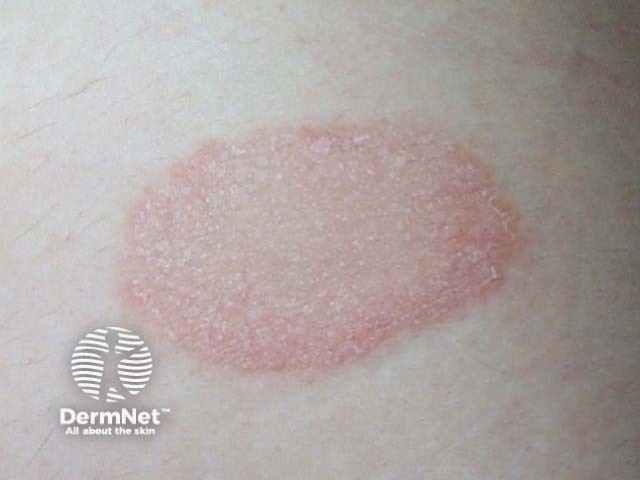
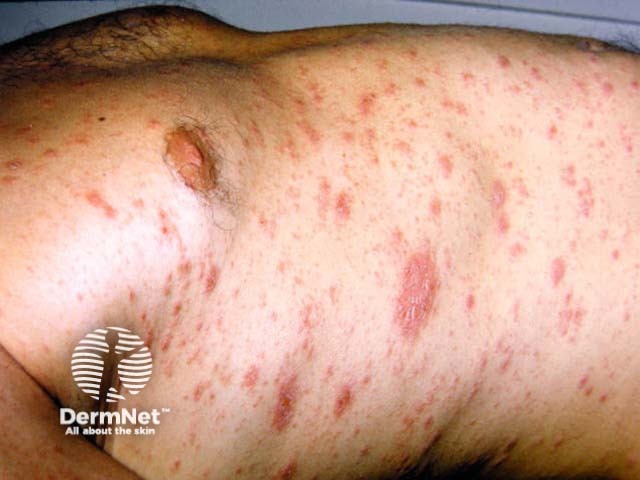
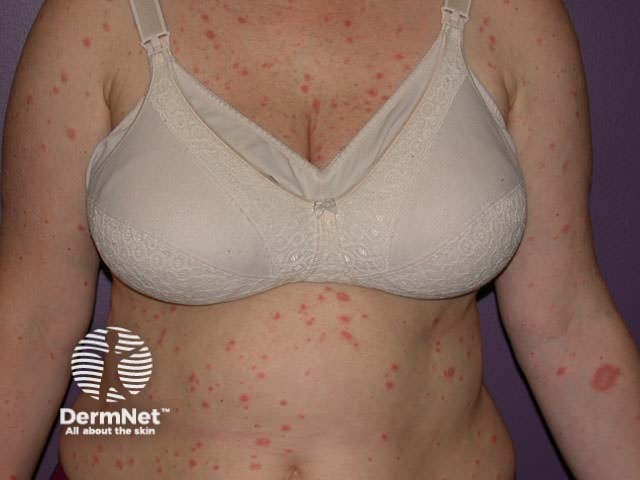
Pityriasis rosea resolves in about six to twelve weeks and rarely recurs.
Itching is reduced by mild potency topical steroids. Extensive or persistent cases can be treated by UVB phototherapy.
Gianotti Crosti syndrome
The Gianotti Crosti syndrome (papulovesicular acrodermatitis, papular acrodermatitis of childhood, acrodermatitis papulosa infantum) is a characteristic papular rash arising in young children aged 6 months to 12 years. It persists for 2 to 8 weeks.
The specific viruses causing Gianotti Crosti Syndrome include:
- Hepatitis B infection
- Epstein Barr virus (the cause of glandular fever)
- Coxsackie viruses
- Echo viruses
- Respiratory syncytial virus
Over the course of 3 or 4 days a profuse eruption of erythematous macules, papules, plaques and sometimes vesicles develops first on the thighs and buttocks, then on the outer aspects of the arms, and finally on the face. The rash is often asymmetrical and is not particularly itchy.
Recurrence of the Gianotti Crosti Syndrome is unlikely but has been reported.
Gianotti Crosti syndrome 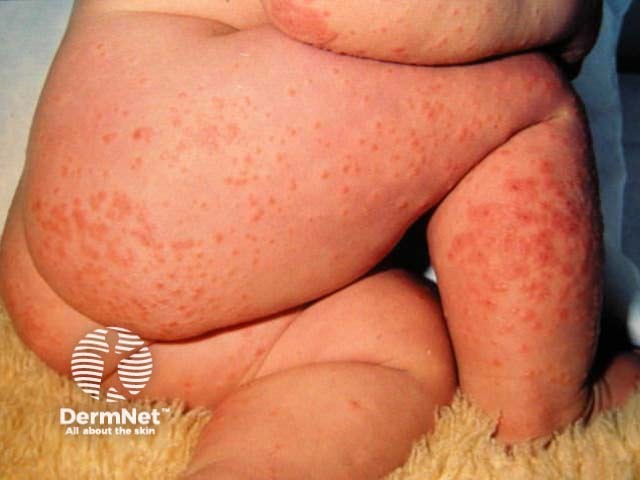
Laterothoracic exanthem
Laterothoracic exanthem is also known as Asymmetric Periflexural Exanthem of Childhood (APEC). It is an uncommon rash affecting young children (especially girls), and is thought to be due to a viral infection.
The rash usually starts in the armpit or groin and gradually extends outwards, remaining predominantly on one side of the body. It may spread to the face, genitalia, hands or feet and may persist for up to twelve weeks.
Tiny papules slowly coalesce into itchy dry plaques, resembling dermatitis. The middle of older patches fades to a dusky grey. Occasionally the patches are net-like or in rings.
Laterothoracic exanthem 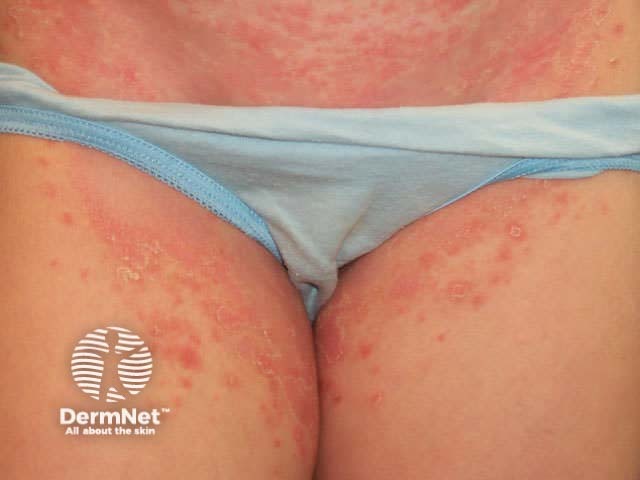
Sometimes other features of viral infection occur at the onset of the rash, inclduing fever, sore throat, rhinitis, vomiting and/or diarrhoea and localised lymphadenopathy.
Kawasaki disease
Kawasaki disease (mucocutaneous lymph node syndrome) is uncommon in New Zealand. The highest incidence is in children of Asian descent especially Japanese. There are 5000-6000 cases each year in Japan. Kawasaki disease is currently the leading cause of acquired heart disease in children in the United States and Japan.
80% of cases occur in children younger than 4 years of age. In some cases it is associated with known superantigens such as streptococci but the precipitating cause may be viral in others.
The exanthem predominantly affects perioral and genital areas but may be diffuse, with swollen fingers and toes that later peel. The child is unwell with fever, lymphadenopathy, conjunctivitis and strawberry tongue. There is widespread inflammation of small- and medium-sized blood vessels, in particular, the coronary arteries.
Kawasaki disease 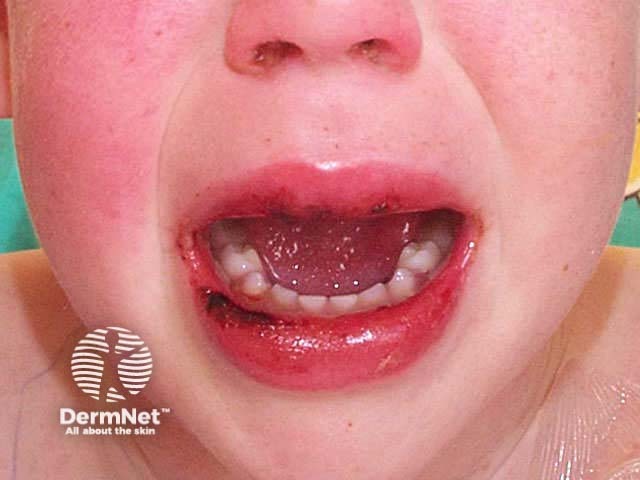
Aspirin/ immune globulin may prevent cardiac aneurysms.
Kawasaki disease is usually self-limiting and resolves spontaneously without treatment within 4-8 weeks. However, 15-20% of cases will have some damage to coronary arteries and approximately 2% of patients will die from a heart attack.
Activity
Discuss the evidence for viral aetiology in Kawasaki disease, pityriasis rosea and/or Gianotti Crosti syndrome.
References:
On DermNet:
Information for patients
Other websites:
- Medscape Reference: Viral infections
- Merck Manual Professional:
Books about skin diseases:
See the DermNet bookstore
